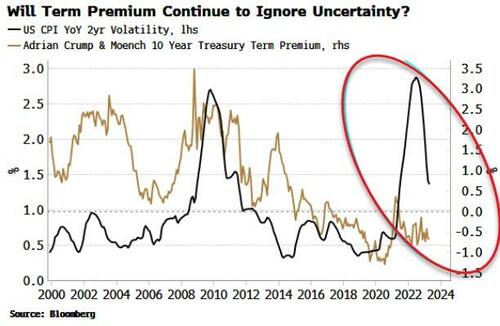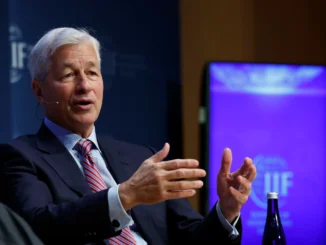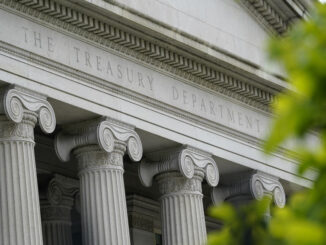
Authored by Simon White, Bloomberg macro strategist,
Higher bond yields are an increasingly likely prospect as rising inflation expectations push bondholders to demand an extra premium to lend money.
It’s been a testament to the Fed’s inflation-fighting credibility that – despite almost double-digit CPI – bond yields have not risen even more. The central bank’s own two-year forecast for PCE inflation never got above 3%, and based on the behavior of term premium – the extra yield bond holders demand above what is implied by long-run rate expectations – the market has taken the Fed at its word.
Since bond yields bottomed in August 2020, virtually the entire rise has been accounted for by expectations of Fed rate increases.
But bondholders’ benefit of the doubt may not last much longer. Friday saw the release of the latest University of Michigan data on consumers’ inflation expectations. The median 5-10 year inflation expectation rose to 3.2% from 3% last month, a 30-year high apart from a brief blip during the GFC in 2009.
The rise in long-run inflation expectations to cycle highs despite CPI peaking almost a year ago is a reminder that inflation indices capture the price move when it happens, but consumers don’t experience the inflation until they actually make a purchase. Many purchases are made irregularly so consumers are just beginning to “feel” inflation.
This is a problem as rising inflation expectations risk inflation becoming unanchored. That’s when bondholders begin to notice. The chart below shows that longer-term inflation expectations lead term premium by about a year, and anticipates the latter should soon start rising.
This is one of several reasons (discussed here) to expect higher bond yields in the coming months.
Higher inflation is big source of uncertainty, not just for markets, but for investment and for consumption. Fed surveys are pointing to a drop-off in capex, while the Katona Effect describes how consumers tend to save more and spend less when volatility of inflation high.
Term premium, too, tends to rise when inflation vol rises, but so far it has not responded.
But rising inflation expectations and a greater risk of unanchored inflation may soon have something to say about this.
Loading…



